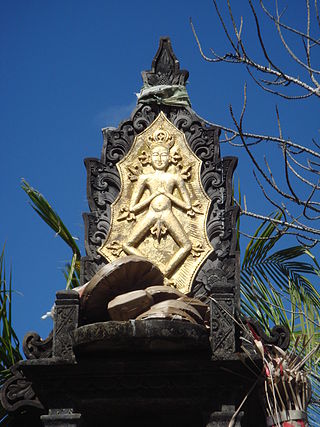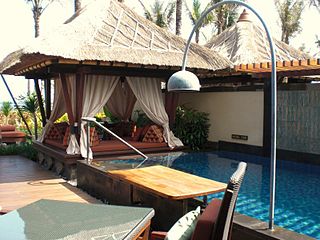
Balinese Hinduism is the form of Hinduism practised by the majority of the population of Bali. This is particularly associated with the Balinese people residing on the island, and represents a distinct form of Hindu worship incorporating local animism, ancestor worship or Pitru Paksha, and reverence for Buddhist saints or Bodhisattava.

Hinduism in Indonesia, as of the 2018 census, is practised by about 1.74% of the total population, and almost 87% of the population in Bali. Hinduism was the dominant religion in the country before the arrival of Islam and is one of the six official religions of Indonesia today. Hinduism came to Indonesia in the 1st-century through Indian traders, sailors, scholars and priests. A syncretic fusion of pre-existing Javanese folk religion, culture and Hindu ideas, that from the 6th-century also synthesized Buddhist ideas as well, evolved as the Indonesian version of Hinduism. These ideas continued to develop during the Srivijaya and Majapahit empires. About 1400 CE, these kingdoms were introduced to Islam from coast-based Muslim traders, and thereafter Hinduism, which was previously the dominant religion in the region, mostly vanished from many of the islands of Indonesia.

Besakih Temple is a pura complex in the village of Besakih on the slopes of Mount Agung in eastern Bali, Indonesia. It is the most important, the largest and holiest temple of Balinese Hinduism, and one of a series of Balinese temples. Perched nearly 1000 meters up the side of Gunung Agung, it is an extensive complex of 23 separate but related temples with the largest and most important being Pura Penataran Agung. The temple is built on six levels, terraced up the slope. The entrance is marked by a candi bentar, and beyond it the Kori Agung is the gateway to the second courtyard.

Tanah Lot is a rock formation off the Indonesian island of Bali. It is home to the ancient Hindu pilgrimage temple Pura Tanah Lot, a popular tourist and cultural icon for photography.

Uluwatu Temple is a Balinese Hindu sea temple located in Uluwatu. The temple is regarded as one of the sad kahyangan and is dedicated to Sang Hyang Widhi Wasa in his manifestation as Rudra.

Achintya, also known as Sang Hyang Widhi Wasa and Sang Hyang Tunggal, is the Supreme God of Indonesian Hinduism, especially on the island of Bali. Achintya is equivalent to the metaphysical concept of Brahman of Indian Hinduism, and is the Supreme God in traditional wayang theatre. All gods, goddesses and existence are believed to be the manifestation of the Achintya in Balinese Hinduism.
Pura Dalem Agung Padangtegal, or Padangtegal Great Temple of Death, is one of three Hindu temples making up a temple complex located in the Sacred Monkey Forest Sanctuary – commonly called the "Ubud Monkey Forest" – of Padangtegal, Ubud, Bali, Indonesia.

Hyang is a representation of the supreme being, in ancient Java and Bali mythology. The spiritual entity can be either considered as divine or ancestral. The reverence for this spiritual entity can be found in the folk religions of Java and Bali, such as the Sunda Wiwitan, Kejawen, Kapitayan, and Gama Tirta. The realm where Hyang resides is called the Kahyangan, which is an Old Javanese term that literally means "the abode of Hyang", "part of Hyang", or "heaven".

A pura is a Balinese Hindu temple, and the place of worship for adherents of Balinese Hinduism in Indonesia. Puras are built in accordance to rules, style, guidance and rituals found in Balinese architecture. Most puras are found on the island of Bali, where Hinduism is the predominant religion; however many puras exist in other parts of Indonesia where significant numbers of Balinese people reside. Mother Temple of Besakih is the most important, largest and holiest temple in Bali. Many puras have been built in Bali, leading it to be titled "the Island of a Thousand Puras".

Canang sari is one of the daily offerings made by Balinese Hindus to thank the Sang Hyang Widhi Wasa in praise and prayer. Canang sari will be seen in the Balinese temples (pura), on small shrines in houses, and on the ground or as a part of a larger offering.

Balinese architecture is a vernacular architecture tradition of Balinese people that inhabits volcanic island of Bali, Indonesia. The Balinese architecture is a centuries-old architectural tradition influenced by Balinese culture developed from Hindu influences through ancient Javanese intermediary, as well as pre-Hindu elements of native Balinese architecture.

A Meru tower or pelinggih meru is the principal shrine of a Balinese temple. It is a wooden, pagoda-like structure with a masonry base, a wooden chamber and multi-tiered thatched roofs. The height of Meru towers represent the Hindu Mount Meru. Meru towers are usually dedicated to either the highest gods of the Hindu pantheon, the local pantheon, or a deified person.

In a Balinese temple architecture, a Bhoma is a carved or formed grotesque which decorates certain parts in the Balinese temple complex. The statue is similar to the Javanese Kala, and was intended to protect the temple complex from malevolent spirits.

Pura Kehen is a Balinese Hindu temple located in Cempaga, Bangli Regency, Bali. The temple is set on the foot of a wooded hill, about 2 kilometres (1.2 mi) north of the town center. Established at least in the 13th-century, Pura Kehen was the royal temple of the Bangli Kingdom, now the Regency of Bangli.

Pura Taman Saraswati, officially Pura Taman Kemuda Saraswati, also known as the Ubud Water Palace, is a Balinese Hindu temple in Ubud, Bali, Indonesia. The pura is dedicated to the goddess Sarasvati. Pura Taman Saraswati is notable for its lotus pond.

Pura Goa Lawah is a Balinese Hindu temple or a pura located in Klungkung, Bali, Indonesia. Pura Goa Lawah is often included among the Sad Kahyangan Jagad, or the "six sanctuaries of the world", the six holiest places of worship on Bali. Pura Goa Lawah is noted for built around a cave opening which is inhabited by bats, hence its name, the Goa Lawah or "bat cave".

Pura Penataran Agung Lempuyang is a Balinese Hindu temple or pura located in the slope of Mount Lempuyang in Karangasem, Bali. Pura Penataran Agung Lempuyang is considered as part of a complex of pura surrounding Mount Lempuyang, one of the highly regarded temples of Bali. The temples of Mount Lempuyang, represented by the highest pura at the peak of Mount Lempuyang, Pura Lempuyang Luhur, is one of the Sad Kahyangan Jagad, or the "six sanctuaries of the world", the six holiest places of worship on Bali.

Pura Dasar Buana is a Balinese Hindu temple or pura located in Gelgel, Bali, about 3 kilometres (1.9 mi) from Semarapura. Pura Dasar Buana is one of the Pura Dang Kahyangan Jagat, a temple which was built to honor a holy teacher of Hindu teaching. Pura Dasar Buana honored Mpu Ghana, a Brahmin who arrived to Bali from Javanese Majapahit to teach Hinduism in the island.
Nelu Bulanin, also known as Upacara Nelu Bulanin and Niskramana Samskara, is a traditional ceremony held in Bali, Indonesia. The ceremony commemorates an infant baby who has reached three months, per the Pawukon calendar, or 105 days of age. The name "Nelu Bulanin" is from the Balinese language, "Nelu" or "Telu" meaning three and "Bulan" meaning month.


















